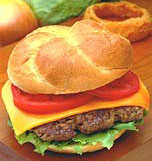 Fast food restaurants are feeding the obesity epidemic by tricking people into eating many more calories than they mean to, an important study has shown. Fast food restaurants are feeding the obesity epidemic by tricking people into eating many more calories than they mean to, an important study has shown.
Typical menus at McDonald's, KFC and Burger King contain 65 per cent more calories per bite than standard British meals, making it far too easy ffor customers to overindulge without realising it. The high "energy density" of junk food - the amount of calories it contains in relation to its weight - throws the brain's appetite control system into confusion, as this is based on the size of a portion rather than its energy content. The critical role of energy density in obesity has been revealed by Andrew Prentice, Professor of International Nutrition at the London School of Hygiene and Tropical Medicine, and Susan Jebb, of the Medical Research Council Human Nutrition Centre in Cambridge. In a study published in the journal Obesity Reviews, they calculated the average energy density of menus at McDonald's, KFC and Burger King, using nutritional data from the fast food chains' websites. The average energy density of these restaurants' meals was 263 calories per 100 grams, 65 per cent more than the density of the average British diet and more than twice that of a recommended healthy diet. This means that a person eating a Big Mac and fries would consume almost twice as many calories as someone eating the same weight of pasta and salad. Professor Prentice said that the human appetite encouraged people to eat a similar bulk of food, regardless of its calorific value. This left regular consumers of fast food prone to "accidental" obesity, in which they grew fat while eating portions they did not consider large. Professor Prentice added: "Since the dawn of agriculture, the systems regulating human appetites have evolved for the low-energy diet still consumed in rural areas of the developing world, where obesity is almost non-existent. Our system of appetite control is completely unpicked by the junk food diet." When fast food is eaten often, even small miscalculations of portion size can have major effects, the study found. If a person eats 200g extra of fast food with a density of 1,200kJ per 100g just twice a week, he would consume an extra 250,000kJ a year. This is enough to put on almost 8kg of fat. Fast food outlets should reduce the energy density of their menus as well as their portion sizes, the scientists said. (Agencies)
| 一项重要的研究显示:快餐店引诱人们摄入的卡路里远远超过他们实际所需要的量,结果助长了肥胖病的流行。 麦当劳、肯德基和汉堡王的代表食品每一口的卡路里含量都比普通的西餐高出65%,让消费者们很容易就在不知不觉中摄入了过多的卡路里。 垃圾食品含有很高的“能量密度”,即食物重量和卡路里含量的比例。垃圾食品往往使大脑的食欲控制系统陷入混乱,因为控制系统判断的标准是食物份量的大小而不是热量含量的高低。 伦敦公共医学与热带医学学院的国际营养学教授安德鲁·普伦蒂塞和剑桥大学医学研究学会人类营养研究中心的苏姗·杰布已经揭示了能量密度在导致肥胖中的关键性作用。
《肥胖评论》杂志发表了他们的研究结果,他们通过快餐连锁网站上的营养数据计算了麦当劳、肯德基和汉堡王食品的平均能量密度。 这些快餐店食品的平均能量密度是每一百克263卡路里,比英国日常饮食的能量密度高出65%,是推荐的健康饮食能量密度的两倍多。这意味着吃一个巨无霸和炸薯条所摄入的卡路里差不多是吃同样重量的意大利面和色拉所摄入热量的两倍。 普伦蒂塞教授说人类的食欲诱使他们摄入相似体积的食物,而不顾食物的卡路里含量。这就使得那些经常吃快餐的人在不经意间就变胖了,而他们自己却并没觉得吃的特别多。 普伦蒂塞教授补充说:“从农业产生以来,人类的食欲调节系统不断向低能量进化。在发展中国家的农村,人们饮食中热量的含量还是很低的,在这些地方,肥胖病几乎不存在。我们的食欲控制系统完全被垃圾食品搞乱了。”
研究发现:如果你经常吃快餐食品,即使份量上很小的差异都会造成很大的影响。如果一个人每周两次多摄入200克能量密度为1200千焦/百克的快餐食品,他每年多摄入的热量就会达到25万千焦,这足以增加近8千克脂肪。 科学家们指出,快餐店不仅要降低食品的能量密度,而且要缩小食品的体积。
(中国日报网站译)
|
